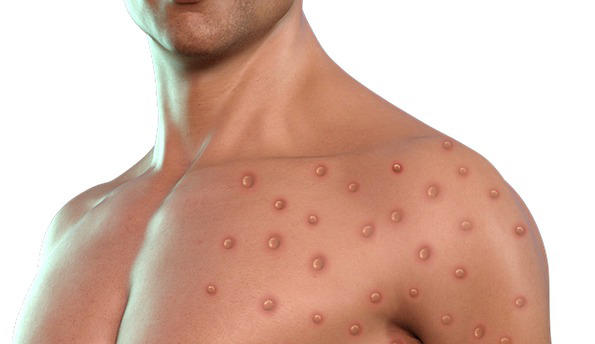
Caption
This is a digital representation of a person infected with monkeypox. A suspected case of monkeypox virus in an Atlantan is being tested by the Centers for Disease Control and Prevention.
Credit: Pixabay
|Updated: June 6, 2022 9:39 AM
A suspected case of monkeypox virus in Georgia may have people concerned about transmission. But pathologists say protecting yourself against COVID-19 is still more important. GPB’s Ellen Eldridge has more.

This is a digital representation of a person infected with monkeypox. A suspected case of monkeypox virus in an Atlantan is being tested by the Centers for Disease Control and Prevention.
A metro Atlanta man with a history of international travel has a confirmed case of orthopoxvirus, which is in the same genus as monkeypox, according to the Georgia Department of Public Health.
As the Atlanta-based Centers for Disease Control and Prevention tests to confirm whether this is a case of monkeypox, some residents may worry about their risk of infection.
Monkeypox was first discovered in 1958 when two outbreaks of a pox-like disease occurred in colonies of monkeys kept for research, thus leading to the naming of the disease.
It originates in various wild animals, not only monkeys, and can be transmitted if a person comes into contact with the virus from an animal, a human or contaminated materials.
The virus enters the body through broken skin, the respiratory tract, or mucous membranes in the eyes, nose or mouth.
Animal-to-human transmission may occur by bite or scratch, through preparation of an infected animal for food, direct contact with body fluids or lesion material, or indirect contact with lesion material such as via contaminated bedding, the CDC says. African rodent species are suspected to play a role in transmission.
Human-to-human transmission is thought to occur primarily through large respiratory droplets. Respiratory droplets generally cannot travel more than a few feet, so prolonged face-to-face contact is required.
Last July, 43 people in Georgia were monitored for monkeypox. They passed through the 21-day period for potential infection, and there were no reports of symptoms among flight crew and passengers, DPH reported.
A traveler on the flight had a confirmed case of monkeypox that did not infect any others.
The monkeypox virus can only be confirmed by CDC lab testing after a state department of health has reason to suspect it, Dr. Christina Wojewoda said.
Wojewoda is the director of clinical microbiology at the University of Vermont Medical Center, and she chairs the Microbiology Committee for the College of American Pathologists.
“We don't want people swabbing every little rash that's out there, overwhelming the public health laboratories (by) testing for things that don't make any sense at all,” she said.
Officials must make sure that the signs, symptoms and presentation are consistent before testing is sent from the state lab to the CDC.
The CDC as of Tuesday was tracking 18 confirmed monkeypox cases across the country in California, Utah, Massachusetts, Florida and, now, Georgia.
Wojewoda said the public should not be afraid of the monkeypox virus, which is far less common or transmissible than the virus that causes COVID-19.
“You're not going to get (monkeypox) going out to eat at a restaurant, probably not even having friends over at a dinner party,” she said. “This is really more intimate contact. So, this is still pretty rare.”
In the past five years, scientists have confirmed only eight cases where travelers carried monkeypox to countries outside Africa, including two cases last year in the United States. Each was linked to a person who had recently spent time in Nigeria, a country that experienced a resurgence in monkeypox starting in 2017.
In those cases, the human-to-human spread was limited, with two family members who became infected in one instance, according to the World Health Organization. One health care worker who had contact with contaminated bedsheets was infected in another case, report experts in an article published in the CDC’s Emerging Infectious Diseases.
“Monkeypox has never appeared more or less simultaneously across different countries and now continents,” Andrea McCollum, the poxvirus epidemiology team lead at the CDC, said in an interview with JAMA.
As of May 21, however, the WHO had confirmed monkeypox among 92 people across 12 countries in Europe and North America, where it is not endemic, with another 28 suspected cases.
Monkeypox endemic countries are: Benin, Cameroon, the Central African Republic, the Democratic Republic of the Congo, Gabon, Ghana (identified in animals only), Ivory Coast, Liberia, Nigeria, the Republic of the Congo, Sierra Leone, and South Sudan.
And unlike the previous cases discovered outside Africa, the current outbreaks have occurred in people with no travel history, suggesting that human-to-human transmission is driving the spread.
Two weeks ago, Wojewoda’s team formed a multidisciplinary group of people in nursing to infectious diseases, emergency departments, outpatient medicine, infection prevention and the laboratory to put together a plan.
“I'd rather be prepared than to have to react to something later,” she said, admitting she didn’t think in 2020 that SARS-CoV-2 would reach Vermont.
The rash is the defining symptom of monkeypox, Wojewoda said.
"Patients, if they have a funny rash, again, should contact their primary care provider and always be open and honest about (their) potential contacts or exposures so that people can get diagnosed as quickly as possible," Wojewoda said.
The pathologist does not believe the general population needs to be really concerned about monkeypox virus.
"I would still urge people to get their COVID-19 vaccinations, wear masks indoors when appropriate, and continue washing hands and all of the precautions that we had for COVID-19 as that is still much more widely circulating than monkeypox," she said.